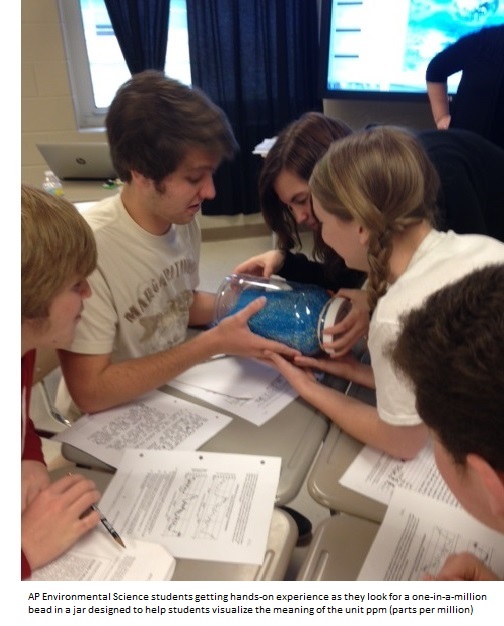Partner School in Alabama Makes it to Samsung Contest Finals
Laura DeMoss |
April 6, 2015
 Students at Alabama’s Lawrence County High School, an A+ College Ready school, are taking steps to protect their community against chikungunya, a painful mosquito-borne viral disease that causes fever and joint pain lasting from a few days to months. For years, experts have warned that global travel and climate warming could create the right conditions for the virus to spread to the Americas from countries in Asia and Africa.
Students at Alabama’s Lawrence County High School, an A+ College Ready school, are taking steps to protect their community against chikungunya, a painful mosquito-borne viral disease that causes fever and joint pain lasting from a few days to months. For years, experts have warned that global travel and climate warming could create the right conditions for the virus to spread to the Americas from countries in Asia and Africa.
BeLinda Cross, a chemistry and environmental science teacher at Lawrence County High School, learned about chikungunya at an event hosted by the Yale Peabody Museum of Natural History last summer. There, she started thinking about how her students could use an investigation of the disease to explore the impacts of climate change. When she and her students later learned that more than one local resident had contracted the virus, they knew they wanted to learn more about the problem.
“If we didn’t know [about chikungunya], then that probably meant others didn’t know,” said Clay Graham, a 17-year-old student in Cross’s AP Environmental Science class, “so we decided to do something about that.”
Cross and her colleague, computer science teacher Gina McCarley, saw the Samsung Solve for Tomorrow contest as the perfect opportunity to galvanize students around this project. The nationwide competition challenges 6th-12th grade student groups to apply STEM knowledge and skills learned in the classroom to pressing issues facing students’ communities.
“Entering the Solve for Tomorrow contest was the ideal way to showcase STEM learning. From the moment the idea is conceived, through the planning phases and into the implementation of all the activities, students are actively engaged,” Cross said. “It doesn’t get any more real-world than this.”
Together, Cross and McCarley launched an effort that brought together 60 students from three courses to investigate and address the potential spread of chikungunya at a local level. The project ultimately earned the group one of 15 coveted finalist spots in the Solve for Tomorrow contest, giving them the opportunity to compete for five national winner positions and a share of over $2 million in technology products.
To establish foundational understanding of climate change and mosquito-borne illness, students conducted background research using scholarly articles. In the laboratory, they incubated mosquito larvae to observe how different temperatures and common substances impact their life cycles. Recognizing community education as a vital component of preventing the spread of chikungunya, students conducted presentations and used social media, a mobile phone app, art displays and multimedia games to teach local residents about the virus and how to control mosquito populations.
Students got hands-on experience as they learned about aquatic habitats with a field trip to the Tennessee Aquarium and met with an ecology expert at the WaterWorks Center for Environmental Education in Hartselle, Alabama. There, they were allowed to capture a small population of Gambusia fish, commonly known as mosquitofish. They used the fish, which eat mosquito larvae, to begin an aquaculture project exploring their potential as one solution for helping safely control the local mosquito population.
“The mosquitofish harvesting at the environmental center was fun. We got to go out into big tanks and scoop them up with dip-nets, then figure out which areas of standing water were safe to release them into,” said Graham. “I got to put some of them in the assistant principal’s pond!”
To share their experience, the students also produced a three-minute video, “Swatting Mosquito-Borne Disease,” which members of the group presented to a panel of judges in New York City in late March, as Samsung prepared to select and announce the national Solve for Tomorrow contest winners.
This isn’t the first time Cross and McCarley have helped students achieve success in the Solve for Tomorrow competition. In 2012, their project addressing their community’s problem with invasive hogs won the national competition. In 2013, their team was the state finalist for Alabama for a project investigating agricultural fertilizer innovations. These successes have boosted student interest in STEM and transformed the school’s classrooms with $100,000 in technology prizes, including a class set of Samsung tablets that serves as a portable computer lab, two interactive touchscreen whiteboards and more.
Besides the potential for winning state-of-the-art technology resources for the school, Cross finds enormous value in the kind of project-based learning that Solve for Tomorrow encourages.
“As these students enter college or begin careers, they absolutely must be able to confidently investigate a problem and brainstorm solutions,” she said. “The collaboration that this contest requires goes a long way toward getting our students ready for what awaits them after high school graduation. And STEM subjects are critically important because it is through them that we analyze the present and design the future.”
The project is helping Cross’s students develop a love of STEM, too. “I enjoyed the research and seeing how the numbers we recorded made a pattern that helped us predict what might happen next,” said Graham. “And I really liked the mystery of it. Even our teachers didn’t have all the answers, but we figured out a plan together.”